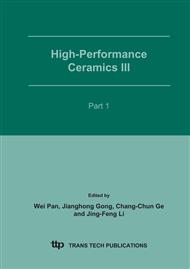p.65
p.69
p.73
p.77
p.79
p.81
p.85
p.89
p.91
Influence of ZrO2 on Dielectric Properties of Ba1-xSrxTiO3 Ceramics
Abstract:
Ba1-xSrxTiO3 ceramic (BST) was one of the promising materials applied in phased array antennas due to its excellent dielectric properties. Ba1-xSrxTiO3 ceramic was prepared by traditional solid state reactions. Effects of different amount of ZrO2 as additive upon the dielectric properties of BST were investigated. The analyzed results showed that, as the amount of ZrO2 increasing, the dielectric constant and temperature dependence of dielectric constant of this ceramic both decreased, while its dielectric tunability kept high value.
Info:
Periodical:
Pages:
79-80
Citation:
Online since:
February 2007
Authors:
Keywords:
Price:
Сopyright:
© 2005 Trans Tech Publications Ltd. All Rights Reserved
Share:
Citation:


